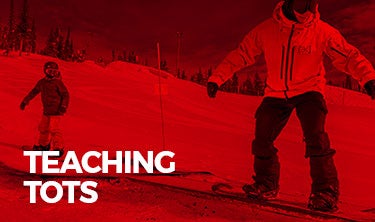Imagine…you are 15 years old, fresh off your Level 1 course, ready to begin your career as a snowboard instructor. Your first day on the job is filled with lessons (yippee!) – a full day of teaching kids, mostly 3 to 5-year old’s. What do you do?
The QuickRide System that you know so well may need to be adapted when teaching the younger riders. Here are a few tips to get the smallest shredders loving the slopes.
Turn Up The FUN!
This goes without saying – keep it fun & engaging. Get to know your student & their likes/dislikes. Make games out of everything.
- Stomp like an elephant (basics/getting familiar with equipment)
- You’re the reindeer/horse pulling the sleigh (sliding two feet on their boards)
- Hop like a bunny
- Simon says
If your young student is having fun, they will leave the lesson remembering how FUN snowboarding is.
Props
Tethers are great tools. Have your student strap both feet in, and tow them around – up & down the hill, along the flats (position & balance), around in circles (edging), over rollers, bumps, jumps, berms, sidehills (position & balance, pressure)
- If no reel on the board, a rope tied to their front foot binding also works
- Or simply hold onto the rope, or onto a hula hoop
It is unreasonable to expect a 3-year-old to push & slide around with 1 foot attached to the board without exhausting themselves. This quickly becomes no fun & too tiring, and we already know how important it is to have FUN.
Terrain Based Learning
Find side hills, small slopes, rollers, bumps. Some resorts have a learning area with these features. Sometimes the most minimal terrain can provide maximum learning. Pulling the younger shredders around different terrain exposes them to opportunities to work on balance, build muscle patterns, and helps them from tiring out too quickly.
J-Turns
Once your young student is feeling comfortable & showing competence sliding with two feet attached (either on a tether or on their own on mellow slopes), try having them look over their shoulder, shine the flashlight or point to the side of the hill (pivot). J-Turns are great to develop some basic pivoting & bring awareness to using their edge to slow down.
Managing (Parent’s) Expectations
This one can be tricky. Remember, if your student leaves the lesson having experienced sliding on snow, had fun & is excited to come back again, that was a successful lesson!
You, the trained professional, have a duty to provide a safe learning environment while keeping your students engaged, having fun, and learning. What some parents expect the lesson outcome to look like, may not align with what they see happening. It’s important to relate what you were doing (pulling the child, hopping around, using appropriate terrain) to what the child was learning. It helps create buy-in by the parents.
And don’t forget to tell the parents your name, so they can request you for the child’s next lesson!
Michelle Clifford
CASI Level 4 Instructor
National Technical Team Member
